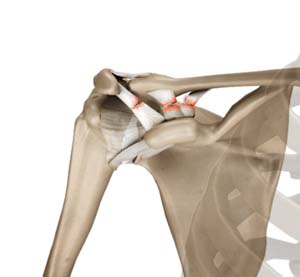
AC Joint Injuries Specialist
AC joint (acromioclavicular joint) injuries can occur when you suffer a hard blow to your shoulder from an accident or fall, and can cause sharp and intense pain and inability to move your arm. Brody Flanagin, MD is an AC joint injuries specialist in Dallas, Texas. Contact Dr. Flanagin’s team to know more about your treatment options!

AC Joint Injuries - Treatment for Shoulder Pain in Dallas, TX (DFW)
About AC Joint Injuries
The acromioclavicular (AC) joint is the area on the shoulder where the clavicle (collarbone) connects to the front portion of the shoulder blade called the acromion. It is the prominent bony area that you can feel if you touch the top of your shoulder. Injuries of the AC joint are common, especially among athletes. There are various types of AC joint injuries that can occur if the shoulder suffers a hard blow through sports trauma, a hard fall, or an accident. The AC joint can become sprained, separated, or fractured. In addition, depending on the degree of the injury and how it was treated, arthritis of the AC joint is a common post-injury occurrence. Dr. Flanagin offers the latest advancements in arthroscopic and open shoulder surgery to surgically repair injuries to the AC joint.
Injury Symptoms
An injured AC joint will create varying symptoms depending on the nature and grade of the injury. For serious conditions, such as a dislocation or separation, sharp and intense pain is often the first symptom The patient will likely be unable to move his or her arm. For sprains, strains, and arthritic conditions, mild to moderate pain and a constant dull ache will exist. Full rotation of the arm will be difficult, and tenderness and shoulder weakness will also occur. Because there are varying injuries associated with the AC joint, we will provide a thorough examination that includes X-rays and digital imaging so that proper treatment can be applied. Some AC joint injuries will require surgery, however many can be treated nonsurgically.
Types of AC Joint Injuries
- AC Joint Strain or Sprain
Wear and tear and general overuse of the shoulder can weaken the AC joint ligaments, which connect the shoulder to the collarbone. This is known as a strain, and can cause a dull ache and shoulder stiffness. When a direct impact or a hard blow hits the top of the shoulder, these weakened ligaments can tear (which is a sprain). A sprained AC joint will cause immediate, sharp shoulder pain, and shoulder weakness. Certain movements, such as reaching for something overhead, lifting, or pulling/pushing movements will be very difficult. Conservative, nonsurgical treatment is usually recommended for this injury.
- AC Joint Separation
A shoulder separation of the AC joint is also caused when the ligaments and tendons weaken due to overuse. A hard or direct fall onto the shoulder can cause a separation, when the ligaments are not strong enough to hold the shoulder in place. When this occurs, the collarbone separates from the shoulder blade. In mild cases, the AC ligament may be partially stretched, but in severe cases, a complete tear will cause immobility and a visible deformity. Nonsurgical treatment typically is effective for treating milder cases, however, in Grade III (severe) cases, shoulder reconstruction surgery is usually necessary to repair the damaged ligaments.
- AC Joint Fractures
Fractures of the AC joint occur when a chip or break occurs within the bone of the joint. This is caused when a direct blow impacts the top of the shoulder. Many cases can be resolved with nonsurgical treatment that includes a sling, rest, and time. However, if the break is severe enough where it punctures through the skin, surgery may be needed to remove fragments and reset the bone so that it heals properly.
- AC Joint Arthritis
Arthritis of the AC joint is a condition commonly seen among active adults, or individuals who suffered trauma or injury to the AC joint. This type of shoulder arthritis begins to develop when the cartilage that surrounds the AC joint begins to degenerate. Dull pain, aches, and shoulder stiffness are common symptoms. Patients diagnosed with shoulder arthritis typically learn to manage their symptoms with conservative treatments such as ice, medication, and limiting certain activities that exasperate the condition. Advanced arthritis can be treated surgically, which usually involves arthroscopic surgery to remove bone spurs, loose cartilage, and fragments. Shoulder replacement surgery may be considered for some patients.
Treatment Options
Many AC joint injuries can be treated nonsurgically, as mentioned above. For lower grade AC joint injuries, the use of a sling, anti-inflammatory medication, rest, and time can heal the AC joint without having to undergo a surgical procedure. Surgery is usually required when advanced symptoms occur, such as ongoing shoulder instability, dislocations, extreme shoulder pain, etc. Arthroscopic shoulder surgery is a minimally invasive technique that can effectively repair the AC joint.
Request a Consult Today
If you are experiencing shoulder pain, as well as symptoms that may be attributed to an injured acromioclavicular joint, we invite you to call our orthopedic office to schedule a consultation so that the healing process can begin. Our team of orthopedic professionals will work together to diagnose the injury and offer a treatment plan to effectively treat the injury or condition.
*Individual results are not guaranteed and may vary from person to person. Images may contain models.




